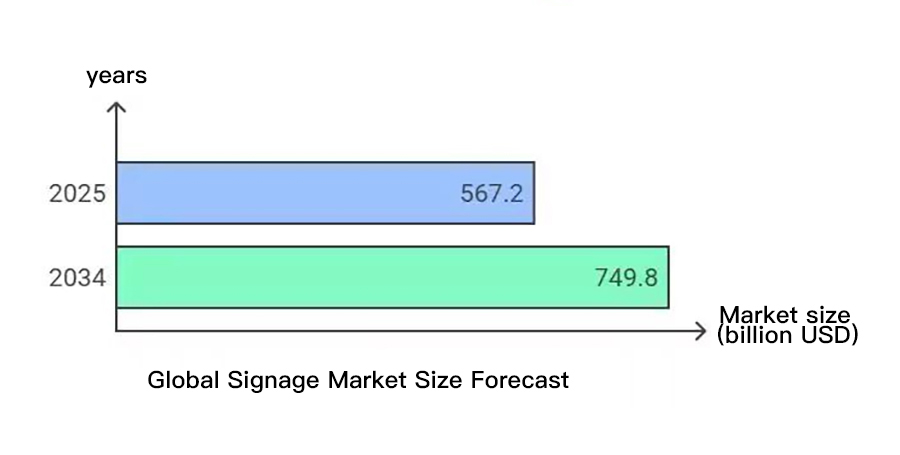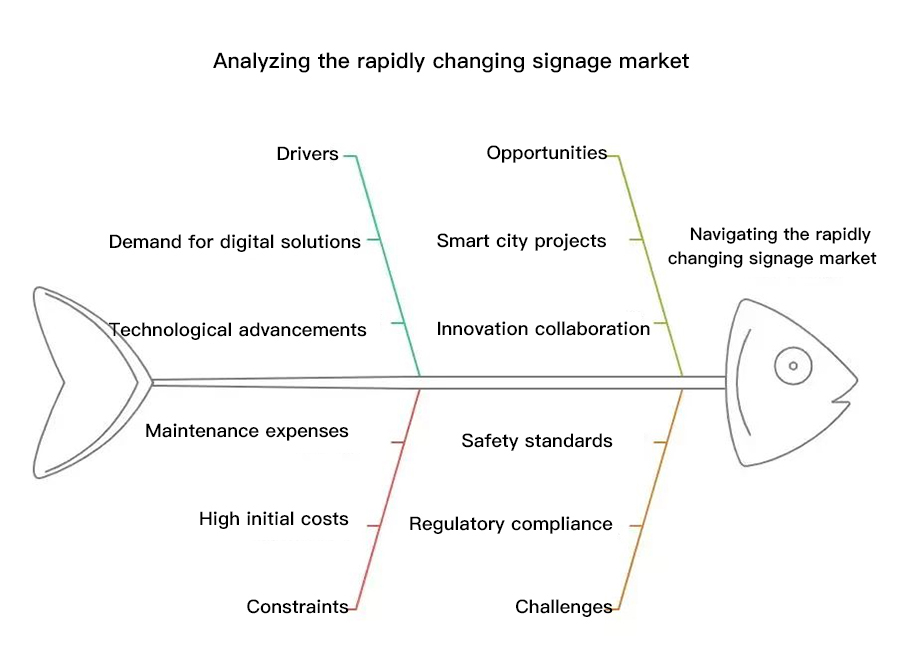Comprehensive Analysis Of The Signage Market In 2025
The global signage market size was estimated at $56.72 billion in 2025 and is expected to reach $74.98 billion by 2034, growing at a compound annual growth rate (CAGR) of 3.15% between 2025 and 2034.

Signage is a way to display information, deliver messages, and increase brand awareness. From stores and transportation hubs to offices and public areas, signage can be found everywhere. Signage includes old-fashioned signs such as billboards and banners, as well as newer digital signs such as LED screens and interactive kiosks. Signage is important for marketing, helping people find their way, and for safety. It conveys a strong and clear message to the right people. As technology advances, with things like artificial intelligence and smart screens, the world of signage is also changing. It meets the growing demand for fun and lively ways to communicate visually.
Impact of major global events
“Digital transformation and the rise of smart signage”
Businesses are becoming increasingly digital and smart cities are emerging, which has led to the use of AI-driven digital signage. Companies now use interactive screens, facial recognition, and data-based content to improve customer engagement and advertising effectiveness. Automation and real-time data analysis trends have accelerated this process, allowing companies to display customized content based on audience characteristics and behaviors. IoT integration in signage allows remote viewing and control, thereby reducing maintenance costs and improving operational efficiency. As more industries go digital, the demand for lively, programmable, data-based signage will increase, changing the way companies communicate with their audiences.
Latest trends
“The rise of AI-driven digital signage”
In the signage world, companies are looking for better ways to connect with their customers, and AI-driven digital signage stands out. These modern displays use AI, facial recognition, and real-time data to display personalized content based on the viewer. Stores, airports, and smart cities now use dynamic signage that changes with the situation to enhance customer experience and advertising impact. AI signage adjusts content based on weather, crowd size, or time of day, making messages more relevant and impactful. As companies invest in data-based marketing, the integration of AI with signage will accelerate, revolutionizing the way businesses communicate with their audiences.
Signage Market Segmentation
By Type
Based on type, the global market can be segmented into video walls, video screens, transparent LED screens, digital posters, billboards, and others.
Video Walls: Video walls are made up of a combination of many screens. They are often seen in public places, control rooms, and events. The video wall market is growing rapidly. This is because display technology is getting better, such as ultra-sharp images and better colors. More and more businesses want eye-catching ads and messages. Therefore, video walls are now popular because it grabs people's attention and focus.
Video Screens: Video screens come in many types, such as LCD, LED, and OLED. They display ads, information, and entertainment. These screens can be found everywhere, including stores, stations, and offices. The video screen market is growing. More and more businesses are using mobile digital content to communicate with their customers. New technologies such as touch screens and interactivity are contributing to market growth. It allows companies to provide people with a more exciting experience.
Transparent LED Screens: Transparent LED screens let light through while displaying bright images. They are often used in store and building designs. They give a modern feel while also allowing you to see behind. More and more brands want to use them for eye-catching displays in stores. They want to improve the shopping experience without blocking the view. As technology advances, it opens up new opportunities for creative advertising and brand storytelling.
Digital Posters: Digital posters are electronic display screens used for advertising and information. They appear in stores, restaurants, and transportation. The market for digital posters is expanding. More and more places use digital signage and want cheap advertising. Brands can change the content displayed from a distance. This allows them to promote products in a timely manner and keep customers interested. This makes digital posters more popular.
Billboards: Billboards are large signs for outdoor advertising. They display information to pedestrians and people driving by. Now, digital billboards can display dynamic images. They attract more attention than old-fashioned static billboards. The billboard market is developing well. Advertisers use busy places to reach many people. Digital billboards can change ads quickly. They are perfect for outdoor advertising that works well.
Others: The “Others” category contains different types of signs. These include kiosks, wayfinding signs, and event signs. They are used to meet special needs in many industries. This category is getting bigger as businesses require customized signs. More and more businesses want signs to be interesting and informative. They are trying new designs and technologies to be seen and heard better.
By Application
Based on the application, the global market can be divided into retail, hospitality, entertainment, stadiums and playgrounds, corporate, and others.
Retail: In the retail industry, signs are very important. They attract customers, showcase products, and make shopping better. Stores now use digital signs, video walls, and touch screens. These help keep shoppers informed about offers. The use of these signs is growing. Brands know that they help increase sales and keep customers happy.
Hospitality: In the hospitality industry, there are signage, menus, and advertisements. These signs help guests find their way and understand what is going on. Good signs make guests feel more satisfied with their stay. More and more businesses are investing money in beautiful signs. This has made the hospitality sign market bigger. Signs make places look nice and tell people about services.
Entertainment: Signs are often used in the entertainment world. They tell people about shows, events, and information. Digital screens and video walls are often seen in theaters, concert halls, and parks. They make visits more interesting and keep people informed. This segment of the market will grow as venues add new sign ideas.
Stadiums and amusement parks: In stadiums and amusement parks, there are signs that display scores, directions, and advertisements. These places often use large digital screens. They display the latest news, fun stuff, and advertisements. More live events and sporting events mean an increase in demand for quality signs. This segment of the sign market is growing.
Corporate: In the corporate world, signage is used for branding, directions, and office conversations. Companies use digital signage to get the message across, keep employees happy, and create a great place to work. More and more companies are doing this. They see the benefits of good signage for branding and communication. This segment of the sign market is growing.
Other: The “other” category includes signs for many industries, such as healthcare, schools, transportation, and public places. Companies in these industries require special signs that meet their needs. This part of the market is likely to grow. Many places require novel, useful and interesting signs. This provides opportunities for sign manufacturers and service providers.
Market Dynamics
Market dynamics include drivers and restraints, opportunities and challenges, explaining the market situation.

Drivers
“Growing Demand for Digital Signage Solutions”
The demand for digital signage is a big driver of the signage market. Companies are always looking for new ways to catch people's eyes. Digital signage provides vivid, eye-catching content and can be changed instantly. Stores, offices and public places are spending money on digital displays to improve the visitor experience and communicate more clearly. Digital signage can be customized to display attention-grabbing messages, advertisements and interactive pieces. In addition, new technologies such as clear displays and content systems make digital signage easier and cheaper for various companies. Therefore, the shift to digital signage will continue to shape the market, promoting growth and new ideas.
Constraints
“High initial costs and maintenance”
A big problem facing the signage market is that advanced signage, especially digital signage, is expensive to start up and maintain. Good screens, software, and setup are expensive. This makes it difficult for smaller companies to use these technologies. In addition, keeping them running, updated, and repaired also adds to the price. Companies are worried about recovering costs and needing to upgrade later, so they may not buy new signs. This slows market growth, especially where money is tight. Therefore, manufacturers need to make cheaper and easier to use signs to attract more buyers.
Opportunities
“Expanding smart city initiatives”
The global shift toward smart cities has opened the door to the signage market. Cities are investing in digital devices to improve city life, which has increased the demand for top-notch signage. Smart signage provides real-time updates on traffic, transportation, and emergencies, helping city leaders communicate with residents. In addition, combining signage with IoT technology, cities can collect and study more data to make their signage systems more efficient and faster. As governments push for smart city initiatives, signage companies can come up with new ideas for city signage, driving market growth and making communities more connected.
Challenges
“Compliance and Safety Standards”
Complying with regulations and safety standards is difficult for the signage market. Each locality has its own rules for sign sizes, placement locations, and signage content, making it difficult for companies to design and install them. For example, outdoor advertising may have restrictions on its brightness and visibility. Digital signage must adhere to rules regarding the content it displays. Ensuring that signage is secure and long-lasting, especially in inclement weather, is key to branding and trust. Companies need to understand local laws and industry rules to avoid legal issues and ensure their signage is safe. This makes signage projects more difficult to complete.
Regional Insights on the Signage Market
North America
The signage industry in North America is top-notch and is known for cutting-edge technology and digital signage. The United States is leading the way, with high demand in the retail, healthcare, commercial, and entertainment industries. Major cities such as New York and Los Angeles showcase the latest in digital and interactive signage. With the boom in e-commerce, brick-and-mortar stores are investing in dazzling signage to attract crowds and improve the shopping experience. IoT technology in signage provides real-time updates and insights, helping companies tailor their messages. Clear advertising and safety rules make it easy for signage companies to do business. As tastes change, sustainability takes center stage, driving the demand for eco-signage.
Europe
The signage market in Europe is colorful, focusing on new ideas and environmental protection. Leading countries such as Germany, France, and the UK use top technologies such as digital and smart signage. Strict regulations help businesses choose eco-friendly materials and energy-saving signage. Digital signage in stores promotes customer interaction and makes shopping fun. Public places and transportation hubs use digital displays to provide real-time information. Europeans prefer personal and local information, driving the demand for customized signage. The signage market will grow as Europe promotes green technology and companies commit to innovation and responsibility.
Asia
The signage market in Asia is booming due to urban development, economic prosperity, and people's increased spending power. China, Japan, and India are leading the trend, investing heavily in infrastructure and smart cities. In China, digital signage is everywhere, with huge LED screens in busy venues and stores. The Japanese love the new state-of-the-art signage that makes shopping and entertainment time better. India’s middle class and retail market are growing, providing huge opportunities for signage companies. However, different cultures and rules across Asia pose challenges. As technology advances, people want more interactive, personalized signage. In short, Asia’s signage market has a lot of room for growth and innovation as companies meet new consumer tastes and technology trends.
Major Industry Players
"Competitive Landscape of the Signage Market"
The signage market is highly competitive, with both large tech companies and specialized companies vying for the top spot. Samsung, LG, and Sony stand out with their cutting-edge displays and extensive product lines such as LED and digital signage. Cisco and Microsoft have added software and networking to their portfolios, making content management a breeze. Smaller brands such as BrightSign and Omnivex focus on niche areas that provide specialized digital signage solutions. Competition is heating up as businesses snap up smart signage and interactive displays, driving companies to innovate. IoT and AI signage are fueling the fire as businesses seek better customer connections and smarter advertising. This competitive landscape will continue to change, and sustainability and eco solutions will be key to staying ahead.
List of Signage Market Companies
Samsung Electronics Co., Ltd.
LG Electronics
Cisco Systems Inc.
Microsoft Corporation
Intel Corporation
Panasonic Corporation
Sony Group Corporation
Key Industry Developments
February 2025: Samsung showcased its latest commercial displays at ISE 2025, featuring AI capabilities that enhance device intelligence, control, and usability.
January 2025: Samsung has been ranked the number one manufacturer in the global digital signage market by market research firm Omdia for the 15th consecutive year.
Report Scope
The study covers a comprehensive SWOT analysis and provides insights into the future development of the market. It examines the various factors contributing to market growth, exploring a broad range of market categories and potential applications that could influence the market's trajectory in the coming years. The analysis takes into account current trends and historical turning points, providing a holistic understanding of the market's components and identifying potential areas for growth.
The global signage market is booming, thanks to corporate demand for more digital and interactive signage. Businesses are investing heavily in advanced signage to attract customers, increase brand awareness, and streamline communication. E-commerce and the need for engaging retail spaces have fueled demand for innovative signage, such as digital displays and navigation systems. Additionally, technological advances such as artificial intelligence, the Internet of Things, and cloud content management are allowing businesses to deliver personalized and vivid content. Signage is now a must-have for modern marketing programs.
The future of the signage market is bright, full of growth opportunities and new ideas. As cities become smarter, integrating signage into the fabric of the city will be essential for public information and conversation. Additionally, as sustainability takes center stage, eco-friendly materials and energy-saving technologies will be sought after. Brands that seize these trends and produce engaging, green, and technologically sophisticated signage will stand out in a tough market. In summary, the market will continue to change, always aiming to enhance user enjoyment and deliver powerful visuals.







